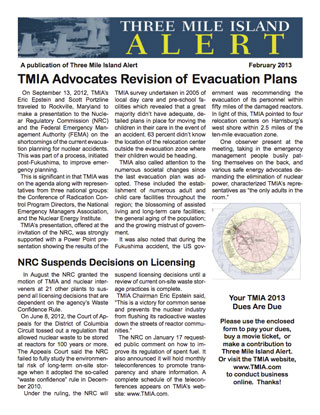Greetings,
Here are a few things we would like to share with you. These documents can also be accessed on our Waste Confidence website: http://www.nrc.gov/waste/spent-fuel-storage/wcd/pub-involve.html#arch. We have documented our last public meeting:
· January 16 teleconference status meeting summary (ADAMS Accession No. ML13032A100).
· January 16 teleconference status meeting transcript (ADAMS Accession No. ML13029A238).
Also, we have announced our next upcoming Monthly Public Teleconference Status Meeting:
· February 20 from 1:30 p.m. – 2:30 p.m. EST, Meeting Notice.
· Prior to the start of the meeting, please dial 1-800-857-2553 and provide the operator with passcode 3682386.
The NRC staff will discuss the status of its development efforts related to the Waste Confidence generic environmental impact statement and rule, and provide additional background information (e.g., documents to be released, public meeting schedules) as warranted. Interested parties are invited to participate and ask questions; however, please note that discussion in this forum will not be considered as formal comments and will not be considered in the EIS development.
Coming up, the NRC is scheduled to issue a Scoping Summary Report in early March 2013, and the Waste Confidence draft EIS is scheduled to be published in late summer or early fall 2013. The publication of the draft EIS is another important opportunity for public participation. The NRC will be conducting regional and webcast public meetings to discuss the conclusions in the draft EIS, and will be asking for public comments on the draft EIS.
The NRC staff will periodically send out information and updates on the Waste Confidence EIS and rulemaking via the NRC’s WCOutreach@nrc.govdistribution list. This information will include notification of the issuance of the Scoping Summary Report and the draft EIS, as well as information on upcoming teleconferences and meetings and how to comment on the draft EIS.
Sincerely,
Staff of the Nuclear Regulatory Commission
Waste Confidence Directorate
























 Pilgrim Nuclear Power Station declared an emergency when it lost offsite power last Friday night, Feb. 8 as the historic winter storm hit Plymouth head-on. Pilgrim went back on line on Sunday morning, but then had to shut down again. It was restored Tuesday night, according to the
Pilgrim Nuclear Power Station declared an emergency when it lost offsite power last Friday night, Feb. 8 as the historic winter storm hit Plymouth head-on. Pilgrim went back on line on Sunday morning, but then had to shut down again. It was restored Tuesday night, according to the 
